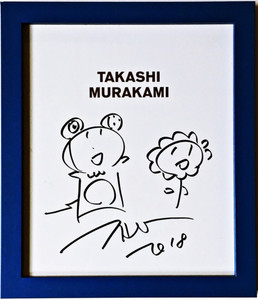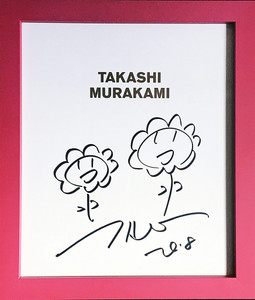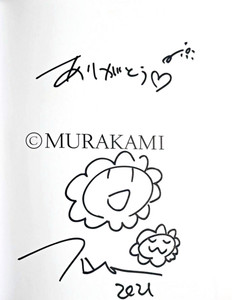
Takashi Murakami, Unique flower drawing, created for the Modern Art Museum, Ft. Worth, Texas, 2018
Takashi MurakamiTakashi Murakami
Unique flower drawing, created for the Modern Art Museum, Ft. Worth, Texas, 2018
Original drawing done in marker, bound in monograph title page
Signed by Murakami directly underneath the drawing
11 × 9 1/2 inches
Unframed
This original hand signed drawing by international Pop superstar Takashi Murakami was acquired directly from the Modern Art Museum in Ft. Worth Texas. It was had drawn by the artist - one of a limited number of drawings done in the museum's monographs, exclusively for the museum during his major 2018 retrospective - which is especially desirable since he mostly uses assistants to paint his works. The drawing was done on the title page of the dazzling, illustrated hardback coffee table monograph with dust jacket "The Octopus Eats its Own Leg". It remains bound in the monograph, and can be removed and separated for framing - or kept intact and given as a unique and memorable gift or displayed in a shadow box. The possibilities are numerous.
Book information:
Publisher : Skira Rizzoli; Illustrated edition (May 30, 2017)
Hardcover : 288 pages with color illustrations
Publisher's blurb:
The first major U.S. monograph in ten years on Murakami is the definitive survey of the paintings of one of today’s most influential artists.
Takashi Murakami (b. 1962), one of contemporary art’s most widely recognized exponents, receives a long-awaited critical consideration in this important volume. Accompanying the first retrospective exhibition devoted solely to Murakami’s paintings, this book traces Murakami’s career from his earliest training to his current studio practice.
Where other books address the commercial aspects of Murakami’s work, this is the first serious survey of his work as a painter. Through essays and illustrations— many previously unpublished—it explores the artist’s relationship to the tradition of Japanese painting and his facility in straddling high and low, ancient and modern, Eastern and Western, commercial and high art. New texts address Murakami’s output in the context of postwar Japan, situating the artist in relation to folklore, traditional Japanese painting, the Tokyo art scene in the 1980s and 1990s, and the threat of nuclear annihilation. This richly illustrated volume also includes a detailed biography and exhibition history. Takashi Murakami is a true essential for collectors and fans alike.
About Takashi Murakami:
We want to see the newest things. That is because we want to see the future, even if only momentarily. It is the moment in which, even if we don’t completely understand what we have glimpsed, we are nonetheless touched by it. This is what we have come to call art.
—Takashi Murakami
Drawing from traditional Japanese painting, sci-fi, anime, and the global art market, Takashi Murakami creates paintings, sculptures, and films populated by repeated motifs and mutating characters of his own creation. His wide-ranging work embodies an intersection of pop culture, history, and fine art.
Murakami earned a BA, MFA, and PhD from Tokyo University of the Arts, where he studied nihonga (traditional Japanese painting). In 1996 he established the Hiropon Factory, a studio/workshop that in subsequent years grew into an art production and artist management company, now known as Kaikai Kiki Co. Ltd.
Since the early 1990s Murakami has invented characters that combine aspects of popular cartoons from Japan, Europe, and the US—from his first Mr. DOB, who sometimes serves as a stand-in for the artist himself, to various anime characters and smiling flowers, bears, and lions. These figures act as icons and symbols—hosts for more complex themes of violence, technology, and fantasy.
In 2000 Murakami curated Superflat, an exhibition featuring works by artists whose techniques and mediums synthesize various aspects of Japanese visual culture, from ukiyo-e (woodblock prints of the Edo period) to anime and kawaii (a particular cuteness in cartoons, handwriting, products, and more). With this exhibition, Murakami advanced his Superflat theory of art, which highlights the “flatness” of Japanese visual culture from traditional painting to contemporary subcultures in the context of World War II and its aftermath.
Murakami’s work extends to mass-produced items such as toys, key chains, and t-shirts. In 2002 he began a multiyear collaboration with Marc Jacobs on the redesign of the Louis Vuitton monogram. Murakami then took the radical step of directly incorporating the Vuitton monograms and patterns into his paintings and sculptures. While Murakami’s imagery may appear to present unprecedented characters and forms, many contain explicit art historical references, and some are even direct contemporary updates on traditional Japanese works.
In 2009 Murakami and the esteemed art historian Nobuo Tsuji began a creative dialogue centered on a group of Japanese artists known as the Edo eccentrics. This collaboration led to an exhibition at the Museum of Fine Arts in Boston in 2017, for which Murakami and Tsuji selected Japanese works from the museum’s collection and showed them alongside works by Murakami. The latter included Dragon in Clouds—Red Mutation: The version I painted myself in annoyance after Professor Nobuo Tsuji told me, “Why don’t you paint something yourself for once?” (2010), a red monochrome version of the famous eighteenth-century painting Dragon and Clouds by Soga Shōhaku.
Following the Tōhoku earthquake of 2011 and the subsequent nuclear crisis at Fukushima, Murakami began deeply exploring the impact of historical natural disasters on Japanese art and culture. In his 2014 Gagosian exhibition at West 24th Street in New York, In the Land of the Dead, Stepping on the Tail of a Rainbow, he created an immersive installation of eclectic arhats; deliquescing clones of his fictional creature Mr. DOB; and karajishi, the mythic lions that guard Japanese Buddhist temples, that visitors entered through a replica of a sanmon (sacred gate).
Not only does Murakami merge different time periods, styles, and subject matter in his work, but his approach to art crosses the boundaries between gallery, studio, art fair, and media as well. Along with creating paintings and sculptures, he has hosted art fairs for emerging artists, curated exhibitions, and made films featuring his many characters and motifs. Combining fantasy, science, and history, he shows that none of these categories can be considered in isolation.
Courtesy of Gagosian Gallery











